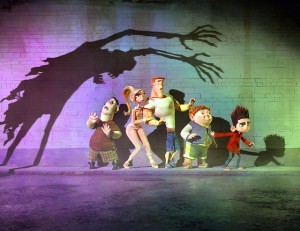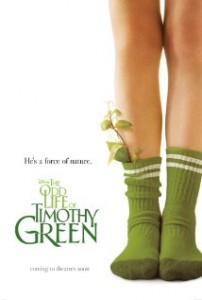 I loved seeing the “ParaNorman” panel at Comic-Con, so I was especially excited to get a chance for an interview with writer-director Chris Butler and co-director Sam Fell, and I had a blast talking to them about why kids and grownups like scary movies and the challenges of stop-action animation.
I loved seeing the “ParaNorman” panel at Comic-Con, so I was especially excited to get a chance for an interview with writer-director Chris Butler and co-director Sam Fell, and I had a blast talking to them about why kids and grownups like scary movies and the challenges of stop-action animation.
You really pretty much made a list of everything that is impossible to do in stop-motion and did it. I mean, tossing toilet paper around?
Chris: I know, that was certainly…
Sam: It was a real trick, there, and I remember when I first wrote that scene I thought, “What would work so well in stop-mo would be toilet paper kind of sculpting forms of zombies…” and then when it came to do it, it was like the most difficult thing you could ever do.
Chris: It was long-time that Brian worked on that toilet paper, it was his specialty, and he was doing it for like a year. He’d come up with these, almost like these platters of toilet paper styles and techniques…
Sam: And we’d go to see it, and he’d say, “Look at this,” and you’ll hold up to the light and you’d say, yeah, I can’t see the wires…And you’d go, oh, that’s pretty good…and you’d make his day because you’d like his toilet paper.
What were some of the other big challenges? At Comic-Con you said no one had ever done stop motion characters with thick necks before.
Chris: Normally with a puppet you want a separate head and then a neck between the two and you can articulate them all around and especially with our technique where we change the faces so there’s a natural line under here, so you can change the faces…but with a fat neck character, it’s very hard to articulate and…
Sam: It does not move the way skin does…
Chris: And there are horrible bulges, and it’s very hard to know how to separate the face from the neck, and this is one shape, so…
Sam: Technically a nightmare. We all knew it was very dangerous territory. We sat around and discussed, “Should we change the design of this character?” And it was like, no, no, because that’s him, and so let’s find a solution to make it work. That’s the approach at Leika and it was the approach on “Coralline.” We took it even further on this. It’s easy to see stop-motion as this little bit of nostalgic history, it’s this cute charming thing from old TV shows. And it’s a beautiful hand-made thing and we loved that aspect of it, but that’s no reason to not take into the future with all the innovations that we have at our disposal.
Chris: We have a visions effects department now integrated into the studio, you know? And it’s all just on desktops, now, so it’s relatively cheap and it’s not like having to go to some big, expensive post-house any more. They’re there, so when you’re designing your shot, you can be, “Hey, come on down,” and they tell us how things should be done or how many passes we need or make suggestions.
Sam: So you can plan a shot around them is what you’re saying, as much as anything.
Chris: It’s very efficient.
If you could take home one of the props for the movie and live with it in your house, what would it be? I know I’d pick the alarm clock!
Sam: Everyone says the alarm clock or the tooth brush.
Chris: I like the van, I guess, or the station wagon. I love those vehicles.
Sam: It’s actually not a prop, but I think it’s a thing of beauty: the dead judge’s cape is so beautiful, it’s a work of art because it’s not just a cape that’s been designed correctly, it’s a cape that’s been designed correctly and then has the asymmetry of the design style, plus it’s animatable, plus it’s got all the rottenness of being in the grave for 300 years. It’s an amazing thing.
Chris: A lot of construction to it.
You tread a very fine line there between scary and reassuring and funny and I love narratively the way you resolve that, but visually, how do you calibrate that and what do you look at?
Chris: The zombies were possibly the scariest thing, they have to play both ways. One thing we knew is that they’ve been in the ground a long time, so we weren’t going to do gore, but I think it was just going through that whole ensemble of zombies and figuring out how they were rotten in the different ways, and that gave us goofy and scary.
Sam: And I think that’s the benefit of telling a story like this in animation—is that you’re already one step removed from reality, so the very process of charactering in the first place is a safe distance, I think, for kids to be, you know…
Chris: To be dealing with a rotting body!
Sam: Yeah, if we’d done this in live-action, it would’ve been more gratuitously gruesome, more grotesque, and I think doing it this way you can design those zombies so that they are cool images…
Chris: and you can have the idea, as well, like we figured out how his face fell off, you know? So his jaw is still flapping, he’s got that flapping bit? But because it’s stylized, it’s sort of art…
Sam: It’s taking advantage of cartooning, if you like, that aspect of animation, whereas I wouldn’t say this movie is a cartoon, because there are real things at stake; you think of the characters as real people, but certainly it’s useful to be able to stylize in that way…
Caricature.
Sam: Yeah, exactly.
(more…)



